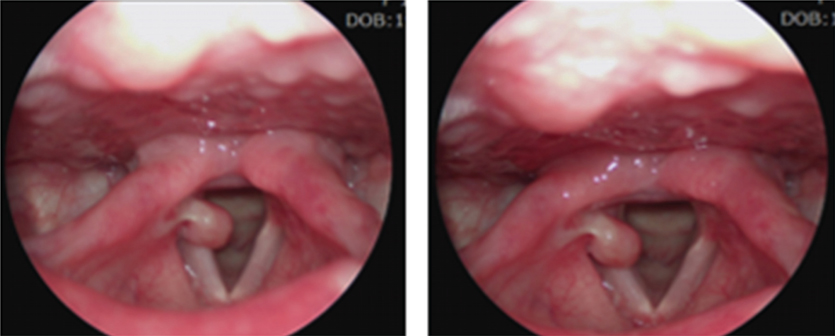J Dent Anesth Pain Med.
2018 Dec;18(6):375-378. 10.17245/jdapm.2018.18.6.375.
Fatal vocal cord granuloma after orthognathic surgery
- Affiliations
-
- 1Department of Oral and Maxillofacial surgery, School of Dentistry, Pusan National University, Yangsan, Republic of Korea.
- 2Department of Dental Anesthesia and Pain Medicine, School of Dentistry, Pusan National University, Dental Research Institute, Yangsan, Republic of Korea. anji1030@naver.com
- 3Department of Anesthesia and Pain Medicine, School of Medicine, Pusan National University, Yangsan, Republic of Korea.
- KMID: 2430215
- DOI: http://doi.org/10.17245/jdapm.2018.18.6.375
Abstract
- Endotracheal intubation is commonly associated with laryngeal injury that often resolves spontaneously without any complication. However, stenosis or granulomatous lesions are generally found on the tracheal wall or vocal process at the tube cuff level, caused by excessive cuff pressure. We present a case of fatal vocal cord granuloma leading to dyspnea following orthognathic surgery and sustained intubation for 14 hours.
Keyword
MeSH Terms
Figure
Reference
-
1. Yilmazer C, Sener M, Yilmaz I. Bilateral giant posterior laryngeal granulomas with dyspnea: a rare complication of endotracheal intubation. Anesth Analg. 2005; 101:1881–1882.
Article2. Yun KI, Lee JA, Park JU. Intubation granuloma: report of a case. J Oral Maxillofac Surg. 2008; 66:1263–1265.
Article3. Barton RT. Observation on the pathogenesis of laryngeal granuloma due to endotracheal anesthesia. N Engl J Med. 1953; 248:1097–1099.
Article4. Drosnes DL, Zwillenberg DA. Laryngeal granulomatous polyp after short-term intubation of a child. Ann Otol Rhinol Laryngol. 1990; 99:183–186.
Article5. Dubick MN, Wright BD. Comparison of laryngeal pathology following long-term oral and nasal endotracheal intubations. Anesth Analg. 1978; 57:663–668.
Article6. de Lima Pontes PA, De Biase NG, Gadelha EC. Clinical evolution of laryngeal granulomas: treatment and prognosis. Laryngoscope. 1999; 109:289–294.
Article7. Blanc VF, Tremblay NA. The complications of tracheal intubation: a new classification with a review of the literature. Anesth Analg. 1974; 53:202–213.8. Barton RT. Medicolegal aspects of intubation granuloma. J Am Med Assoc. 1958; 166:1821–1823.
Article9. Santos PM, Afrassiabi A, Weymuller EA Jr. Risk factors associated with prolonged intubation and laryngeal injury. Otolaryngol Head Neck Surg. 1994; 111:453–459.
Article10. Altun D, Yilmaz E, Basaran B, Camci E. Surgical Excision of Postintubation Granuloma Under Jet Ventilation. Turk J Anaesthesiol Reanim. 2014; 42:220–222.
Article11. Harari PM, Blatchford SJ, Coulthard SW, Cassady JR. Intubation granuloma of the larynx: successful eradication with low-dose radiotherapy. Head Neck. 1991; 13:230–233.
Article
- Full Text Links
- Actions
-
Cited
- CITED
-
- Close
- Share
- Similar articles
-
- Incidental Removal of Pyogenic Granuloma of Vocal Cord during Blind Intubation with Lightwand : A case report
- A Case of Surgical Removal of Hyaluronic Acid Injected in Reinke's Space
- Intubation Granuloma after Orthognathic Surgery: Report of 3 Cases
- Clinical Application of Botulinum Toxin to Contact Granuloma and Vocal Nodule
- Arytenoid Fracture and Vocal Cord Granuloma Resulting from Endotracheal Intubation - 2 cases report





